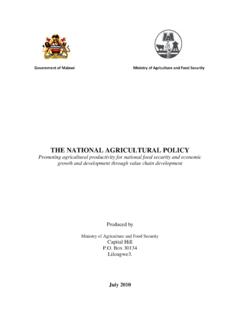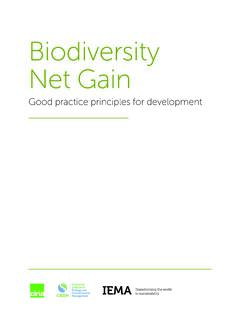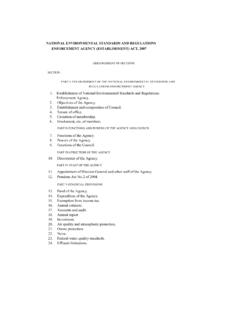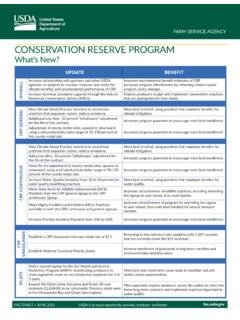Transcription of Conservation Plans - A guide to the preparation of ...
1 1 HERITAGE the Built HeritageConservation PlansA guide to the preparation of Conservation Plans2A guide to the preparation of Conservation has a diverse built heritage: ancient monuments andarchaeological sites and landscapes, historic buildings, townscapes, parksand designed landscapes. The Scottish Executive is committed toconserving the built heritage and using it in a way that meets the needs oftoday without compromising the ability of future generations tounderstand, appreciate and benefit from built heritage needs to be managed and maintained. Aconservation plan is a useful tool to assist those with responsibility forindividual parts of the built heritage to consider the needs of their site,building, monument or landscape (hereafter referred to as site) and how itcan be effectively and efficiently managed.
2 This document offersguidance on the contents and preparation of Conservation guide to the preparation of Conservation preparation of a Conservation plan encourages those withresponsibility for the site to think about it in a structured way, to assesshow and why it is significant, and how it should be managed in orderto conserve that cultural significance. Conservation Plans shouldmeet the needs of the site and the requirements of its owner. Aconservation plan should be as comprehensive as is appropriate forthe size and complexity of the site: the plan required for a category Clisted residential property or a simple field monument will be a verydifferent (and much shorter) document than that required for a largeor complex building or A Conservation plan must be a living document, having a clearlydefined purpose, and which is used and updated as required.
3 Thepreparation of a Conservation plan must not be an end in itself, but beconsidered as a necessary management tool. A Conservation planshould pay dividends in the long term by providing a firm foundationfor management and expenditure The objectives of a Conservation plan identify the cultural and historic significance of the site, andb. to set out a policy and strategy for the management and conservationof those physical attributes of the site that contribute to thatsignificance. For some Conservation Plans , specialist reports and detailed researchmay be required where circumstances dictate. Consultation on theconservation plan and the action it proposes may also be required insome circumstances (see section 4).
4 What is a Conservation plan ? A guide to the preparation of Conservation INTRODUCTION State the address and give a brief description of the site to which theplan relates; Specify the authorship of the Conservation plan , its date ofpreparation, the stakeholders, and the intended recipients; Identify all those who were consulted on, and contributed to, thepreparation of the Conservation plan , and note any proposed SUMMARY Summarise the main conclusions and recommendations made inthe plan , whether for physical interventions or managementstrategies, under the categories of Urgent, Necessary and Desirable,with a programme and timetable for THE SITE Identify the site by name, address, location, grid reference andcurrent ownership.
5 Provide information on any statutory or non-statutory designations, for example, scheduling, category of listing,location within a Conservation area, or inclusion in the Inventory ofHistoric Gardens and Designed Landscapes. Reference to anynatural heritage, landscape or other designations should also ASSESSMENT OF SIGNIFICANCE Assess and analyse the historical and cultural significance of the site,noting any features of related interest (for example natural heritage).If not already in existence, and where necessary, commissionrelevant specialist reports from, for example, archaeologists,architects, landscape architects, surveyors, structural engineers,architectural, garden, art and furniture historians, ecologists andothers appropriate to the type and scale of the Structure of the Conservation Plan6A guide to the preparation of Conservation PlansPrepare a resources audit, including: a site survey; a schedule ofelements of interest both within the site and the immediate andwider setting; a statement of the recorded history of the site and itscontents; its construction, materials and decoration; hard and softlandscaping.
6 Previous interventions and repairs, and earlier andcurrent uses. It should also identify any gaps in the knowledge of large or complex sites, it is desirable to summarise the assessmentof ASSESSMENT AND ANALYSIS OFCONSERVATION NEEDSH aving identified the cultural significance of the site, an assessment ofits particular problems and sensitivities is required, along withconsideration of the options available for its Conservation . Issues toconsider will include: Identification of the current use of the site and consideration of anyneed for an appropriate change of use; The condition of the site and any need for repair; Any constraints imposed by statutory consent requirements; Actions needed to conserve or restore the setting of the site; Identification of any development issues and opportunities ; Any public access requirements or limitations; Servicing needs; The costs of the various recommended measures; The likely resources available for the site, both immediate and in considered the options available, the proposed actions shouldbe identified and justified.
7 An assessment of the effect on the site ofany proposed works should be prepared, for example by way of atable, checklist or other form. A guide to the preparation of Conservation ACTION plan Having identified what needs to be done, a statement should beprepared setting out the actions necessary to preserve the cultural andhistoric significance of the site. These might include: Repairs needed to any structure, finishes and contents, setting outpriorities and categorising them as Urgent, Necessary and Desirable, asappropriate; Actions required to conserve or restore the setting of the site; Identification of appropriate materials and technical skills and theirsourcing; Compliance with statutory requirements; An ongoing maintenance schedule (see section below); A management plan appropriate to the site (see section below); Provision or retention of public access, and its promotion; Enhancement of the presentation of the site to improve publicunderstanding and enjoyment; Creation of a framework for site management and any futureinterventions.
8 Recording of change, and the maintenance of an archival resource; Opportunities for development, and design Action plan should identify clearly who has responsibility forthe actions proposed. It should also identify possible sources offunding for the implementation of the action plan , with any timerestrictions on REVIEW ARRANGEMENTSThe Conservation plan should set out the arrangements and timescalefor a periodic review of the contents of the plan and theimplementation of the action it guide to the preparation of Conservation SUPPLEMENTARY INFORMATIOND epending on the length and nature of the Conservation plan , someinformation may be better put in Appendices, which, if they arelengthy, may best be contained in a volume separate from theconservation plan itself.
9 The Appendices should include the following, as appropriate:A. Bibliography and reports and documentationC. Plans , photographs and other site data D. Visitor survey dataE. Gazetteer (systematic site survey, its geography and topography) building maintenance schedule, to include:clearing leaves, snow, controlling plant growth, removal of bird soiling,inspecting for insect or fungal attack. Removal of graffiti;minor repairs to slate and tile roofs, repair of leadwork and other roofcoverings, maintenance of thatch, maintenance of rainwater goods;inspection and clearing of underground drainage;repairs to masonry and external finishes;preventative treatment against insect or fungal attack;repairs to internal finishes;glazing and pointing repairs;internal decoration;maintenance of hard and soft landscaping;maintenance of any interpretative panels and presentation guide to the preparation of Conservation Plans9G.
10 Management plan , for example, that for field monuments and historiclandscapes might include:management of grazings and stock;management of vegetation (including bracken control), scrub, treesand forestry;cultivation;erosion control and repair;rabbit control;drainage, wet sites and peat;fencing, quarrying, dumping and storage;vehicles, tracks, services and construction;natural heritage values;metal detecting;reporting of finds;impact of guide to the preparation of Conservation Consultation on Conservation Plans Sometimes, there will be a necessity to consult on the content of aconservation plan . This may happen when the preparation of a planis a pre-condition of applying for grant, or where those responsible fora site wish to take early, informal views, for example from the localauthority, on how they propose to manage and conserve the with the local or wider community may also bedesirable in some instances if what is proposed is likely to have animpact beyond the site itself.








